Steel Strip Defect Sample Generation Method Based on Fusible Feature GAN Model under Few Samples
Abstract
1. Introduction
- (1)
- By introducing a curve size-adjustment function and a dynamic adjustment function for the number of iterations, combined with the ECA (Efficient Channel Attention) attention mechanism, a new generation method called SDE-ConSinGAN is proposed to economically generate images with high quality and a variety of flawed images.
- (2)
- An improved image-cutting and fusion method has been proposed. It can cut and fuse multiple images of the same defect type but different defect characteristics, and then, the images can be treated as a new sample for GAN training for more diversity.
- (3)
- SDE-ConSinGAN is an enhancement method for strip defect datasets; training focuses on the texture details of defect images, guides the generator to learn more noteworthy features, and speeds up training to obtain the best performance for different types of defect images and task results. Experimental results show that defect classification models trained with SDE-ConSinGAN-augmented datasets perform significantly better than datasets composed of other generative models.
2. Related Work
2.1. Surface Defect Classification
2.2. Image-Generation Method
2.3. Image-Fusion Method
3. Materials and Methods
3.1. High-Quality Defect Image Generation Based on SDE-ConSinGAN
3.1.1. Image Size Adjustment
3.1.2. Loss Function
3.1.3. Attention Mechanism
3.1.4. Iteration Times Variation Function
3.2. Image-Feature Fusion Based on Graphcut
4. Experiment and Results
4.1. Dataset
4.2. Single-Image Generation
4.3. Image Cutting and Stitching
4.4. Quantitative Evaluation
4.4.1. Image-Generation Quality
4.4.2. Ablation Contrast Experiment
4.4.3. Defect Sample Classification
5. Discussion
- (1)
- According to the characteristics of the industrial defect dataset, the model places training focus on high image resolution. The image global structure is first roughly learned, and then the texture and style details are given top priority for learning. Meanwhile, through sample feature cutting and splicing, diversity number and feature types can be chosen according to the actual condition of image generation.
- (2)
- In terms of training speed, iteration times are changed in each stage, which can shorten training time and improve model performance. Adding an attention mechanism to the generator allows the training model to focus on feature learning and to neglect background noise.
- (3)
- Based on the analysis of Figure 14, we can conclude that SDE-ConSinGAN endows the network with higher convergence speed and accuracy. Since SDE-ConSinGAN endows more high-resolution training stages, the model is forced to focus on learning the detailed features of the image rather than the global features during the training process, and the generated samples reduce the occurrence of repeated features. On the other hand, modifying the first item of the loss function ensures the stability of the model in the early stage of training. The number of iterations in the high-resolution stage is increased by using dynamically adjusted iterations, which not only speeds up the training speed but also conforms to the global characteristics of model learning. Based on the above adjustments, the problem that ConSinGAN cannot be applied to defective samples is effectively solved. By comprehensively comparing these methods in Figure 13, we noticed that SDE-ConSinGAN has excellent data enhancement capabilities for different types of strip steel defect samples. In particular, when the features are not prominent or obvious, SDE-ConSinGAN performs steadily better.
- (4)
- In Table 2, Table 3 and Table 4, the proposed method achieves lower SSIM and SIFID and faster training speed. However, the performance of other methods is not very satisfactory. The results show that the proposed SDE-ConSinGAN can be trained on a single image. In addition, the training speed is faster, and the average SSIM index of the generated samples is 0.600, which is 0.163 lower than that of ConSinGAN. The average SIFID index is 0.086, which is 0.052 lower than that of ConSinGAN. In Figure 15 and Table 6, the accuracy rate of the defect classification task with the dataset generated by SDE-ConSinGAN reaches 93.02%, which is higher than that of SinGAN and ConSinGAN. It can be concluded that the proposed method can be applied to the generation of strip surface defect samples. The intrinsic reason is that the structure of the strip image has great uncertainty. When the generator learns strip defect categories, it mainly learns from the details such as color and texture. Therefore, it is possible to stably learn and generate similar samples when the gray scale changes obviously have large-scale defect changes and most small features. The networks of other methods do not make weight trade-offs for learning features, and these networks do not increase attention mechanisms. Thus, the sample data obtained via SDE-ConSinGAN have higher diversity and reliability, which proves the feasibility in the field of strip defect image generation.
- (5)
- Compared with ConSinGAN, SDE-ConSinGAN changes the training mode of images. Therefore, in addition to the generation of strip steel defect samples, SDE-ConSinGAN can also be applied to other industrial defects. In a broad sense, SDE-ConSinGAN can be applied to the generation of samples that are insensitive to global features. The shortcoming of this paper is that SDE-ConSinGAN is not effective in processing large block defects, and the efficiency of Graphcut is low, which can be optimized appropriately. Meanwhile, in the follow-up research, the ability of SDE-ConSinGAN to extract image features will be improved, such as by adding edge feature-enhancement modules.
Author Contributions
Funding
Institutional Review Board Statement
Informed Consent Statement
Data Availability Statement
Acknowledgments
Conflicts of Interest
References
- Gao, Y.; Li, X.; Wang, X.V.; Wang, L.; Gao, L. A review on recent advances in vision-based defect recognition towards industrial intelligence. J. Manuf. Syst. 2022, 62, 753–766. [Google Scholar] [CrossRef]
- Cannon, D.F.; Edel, K.O.; Grassie, S.L.; Sawley, K. Rail defects: An overview. Fatigue Fract. Eng. Mater. Struct. 2003, 26, 865–886. [Google Scholar] [CrossRef]
- Zhou, X. Dense Attention-guided Cascaded Network for Salient Object Detection of Strip Steel Surface Defects. IEEE Trans. Instrum. Meas. 2021, 71, 5004914. [Google Scholar] [CrossRef]
- Ding, T.; Li, G.; Liu, Z.; Wang, Y. Cross-Scale Edge Purification Network for salient object detection of steel defect images. Measurement 2022, 199, 111429. [Google Scholar] [CrossRef]
- Huang, G.; Liu, Z.; Maaten, L.; Weinberger, K.Q. Densely Connected Convolutional Networks. In Proceedings of the IEEE Conference on Computer Vision and Pattern Recognition (CVPR), Honolulu, HI, USA, 21–26 July 2017; pp. 4700–4708. [Google Scholar]
- Krizhevsky, A.; Sutskever, I.; Hinton, G.E. Imagenet classification with deep convolutional neural networks. Commun. ACM 2017, 60, 84–90. [Google Scholar] [CrossRef]
- Luo, Q. CAT-EDNet: Cross-Attention Transformer-Based Encoder–Decoder Network for Salient Defect Detection of Strip Steel Surface. IEEE Trans. Instrum. Meas. 2022, 71, 5009813. [Google Scholar] [CrossRef]
- Szegedy, C.; Liu, W.; Jia, Y.; Sermanet, P.; Reed, S.; Anguelov, D.; Erhan, D.; Vanhoucke, V.; Rabinovich, A. Going deeper with convolutions. In Proceedings of the IEEE Conference on Computer Vision and Pattern Recognition (CVPR), Boston, MA, USA, 7–12 June 2015; pp. 1–9. [Google Scholar]
- Niu, S. Defect image sample generation with GAN for improving defect recognition. IEEE Trans. Autom. Sci. Eng. 2020, 17, 1611–1622. [Google Scholar] [CrossRef]
- Carvajal, K.; Chacón, M.; Mery, D.; Acuña, G. Neural network method for failure detection with skewed class distribution. Insight Non Destr. Test. Cond. Monit. 2004, 47, 399–402. [Google Scholar] [CrossRef]
- Wan, X.; Zhang, X.; Liu, L. An improved VGG19 transfer learning strip steel surface defect recognition deep neural network based on few samples and imbalanced datasets. Appl. Sci. 2021, 11, 2606. [Google Scholar] [CrossRef]
- Huang, Q. A template model for defect simulation for evaluating nondestructive testing in X-radiography. IEEE Trans. Syst. Man Cybern. Part A Syst. Hum. 2009, 39, 466–475. [Google Scholar] [CrossRef]
- Goodfellow, I. Generative adversarial nets. Commun. ACM 2020, 63, 139–144. [Google Scholar] [CrossRef]
- Xu, B.; Liu, C. Pavement crack detection algorithm based on generative adversarial network and convolutional neural network under small samples. Measurement 2022, 196, 111219. [Google Scholar] [CrossRef]
- Aggarwal, A.; Mittal, M.; Battineni, G. Generative adversarial network: An overview of theory and applications. Int. J. Inf. Manag. Data Insights 2021, 1, 100004. [Google Scholar] [CrossRef]
- Yinka-Banjo, C.; Ugot, O.A. A review of generative adversarial networks and its application in cybersecurity. Artif. Intell. Rev. 2020, 53, 1721–1736. [Google Scholar] [CrossRef]
- Wang, D. Intelligent recognition model of hot rolling strip edge defects based on deep learning. Metals 2021, 11, 223. [Google Scholar] [CrossRef]
- Shaham, T.R.; Dekel, T.; Michaeli, T. Singan: Learning a generative model from a single natural image. In Proceedings of the IEEE/CVF International Conference on Computer Vision (ICCV), Seoul, Republic of Korea, 27 October–2 November 2019; pp. 4570–4580. [Google Scholar]
- Hinz, T. Improved techniques for training single-image gans. In Proceedings of the 2021 IEEE/CVF International Conference on Computer Vision (ICCV), Waikoloa, HI, USA, 3–8 January 2021; pp. 1300–1309. [Google Scholar]
- Yamashita, R.; Nishio, M.; Do, R.K.G.; Togashi, K. Convolutional neural networks: An overview and application in radiology. Insights Into Imaging 2018, 9, 611–629. [Google Scholar] [CrossRef]
- Liu, Y.; Yuan, Y.; Balta, C.; Liu, J. A light-weight deep-learning model with multi-scale features for steel surface defect classification. Materials 2020, 13, 4629. [Google Scholar] [CrossRef]
- Faghih-Roohi, S. Deep convolutional neural networks for detection of rail surface defects. In Proceedings of the 2016 International Joint Conference on Neural Networks (IJCNN), Vancouver, BC, Canada, 24–29 July 2016; pp. 2584–2589. [Google Scholar]
- Shang, L. Detection of rail surface defects based on CNN image recognition and classification. In Proceedings of the 2018 20th International Conference on Advanced Communication Technology (ICACT), Chuncheon, Republic of Korea, 11–14 February 2018; pp. 45–51. [Google Scholar]
- Li, Y.; Zhao, W.; Pan, J. Deformable patterned fabric defect detection with fisher criterion-based deep learning. IEEE Trans. Autom. Sci. Eng. 2016, 14, 1256–1264. [Google Scholar] [CrossRef]
- Huang, H. Railway infrastructure defects recognition using fine-grained deep convolutional neural networks. In Proceedings of the 2018 Digital Image Computing: Techniques and Applications (DICTA), Canberra, Australia, 10–13 December 2018; pp. 1–8. [Google Scholar]
- Sun, J. Surface defects detection based on adaptive multiscale image collection and convolutional neural networks. IEEE Trans. Instrum. Meas. 2019, 68, 4787–4797. [Google Scholar] [CrossRef]
- Chen, W.; Ju, C.; Li, Y.; Hu, S.; Qiao, X. Sugarcane stem node recognition in field by deep learning combining data ex-pansion. Appl. Sci. 2021, 11, 8663. [Google Scholar] [CrossRef]
- Shorten, C.; Khoshgoftaar, T.M. A survey on image data augmentation for deep learning. J. Big Data 2019, 6, 1–48. [Google Scholar] [CrossRef]
- Salakhutdinov, R. Learning deep generative models. Annu. Rev. Stat. Its Appl. 2015, 2, 361–385. [Google Scholar] [CrossRef]
- Zhang, G.; Liu, Y.; Jin, X. A survey of autoencoder-based recommender systems. Front. Comput. Sci. 2020, 14, 430–450. [Google Scholar] [CrossRef]
- Sohaib, M.; Kim, C.H.; Kim, J.M. A hybrid feature model and deep-learning-based bearing fault diagnosis. Sensors 2017, 17, 2876. [Google Scholar] [CrossRef]
- Lee, D. Autoregressive Image Generation using Residual Quantization. arXiv 2022, arXiv:2203.01941. [Google Scholar]
- Zarra, T. Environmental odour management by artificial neural network–A review. Environ. Int. 2019, 133, 105189. [Google Scholar] [CrossRef] [PubMed]
- Sohn, I. Deep belief network based intrusion detection techniques: A survey. Expert Syst. Appl. 2021, 167, 114170. [Google Scholar] [CrossRef]
- Tan, R.K. An efficient data generation method for ANN-based surrogate models. Struct. Multidiscip. Optim. 2022, 65, 1–22. [Google Scholar] [CrossRef]
- Kingma, D.P.; Welling, M. Auto-encoding variational bayes. arXiv 2013, arXiv:1312.6114. [Google Scholar]
- Oord AVan Kalchbrenner, N.; Kavukcuoglu, K. Pixel recurrent neural networks. In Proceedings of the Machine Learning Research (PMLR), New York, NY, USA, 19–24 June 2016; pp. 1747–1756. [Google Scholar]
- Park, S.W. Review on generative adversarial networks: Focusing on computer vision and its applications. Electronics 2021, 10, 1216. [Google Scholar] [CrossRef]
- Li, Q. Coupled GAN with relativistic discriminators for infrared and visible images fusion. IEEE Sens. J. 2019, 21, 7458–7467. [Google Scholar] [CrossRef]
- Lu, H. GAN-based data augmentation strategy for sensor anomaly detection in industrial robot. IEEE Sens. J. 2022, 22, 17464–17474. [Google Scholar] [CrossRef]
- Li, Q. AF-DCGAN: Amplitude feature deep convolutional GAN for fingerprint construction in indoor localization systems. IEEE Trans. Emerg. Top. Comput. Intell. 2019, 5, 468–480. [Google Scholar] [CrossRef]
- Xu, L.; Skoularidou, M.; Cuesta-Infante, A.; Veeramachaneni, K. Modeling tabular data using conditional GAN. Adv. Neural Inf. Process. Syst. 2019, 32, 1–11. [Google Scholar]
- Zhu, J.Y.; Park, T.; Isola, P.; Efros, A.A. Unpaired image-to-image translation using cycle-consistent adversarial networks. In Proceedings of the 2017 IEEE International Conference on Computer Vision (ICCV), Venice, Italy, 22–29 October 2017; pp. 2223–2232. [Google Scholar]
- Gatys, L.; Ecker, A.S.; Bethge, M. Texture synthesis using convolutional neural networks. Adv. Neural Inf. Process. Syst. 2015, 28, 262–270. [Google Scholar]
- Vinker, Y.; Horwitz, E.; Zabari, N.; Hoshen, Y. Deep single image manipulation. arXiv 2020, arXiv:2007.01289. [Google Scholar]
- Bell, S.; Zitnick, C.L.; Bala, K.; Girshick, R. Inside-outside net: Detecting objects in context with skip pooling and recurrent neural networks. In Proceedings of the 2016 IEEE Conference on Computer Vision and Pattern Recognition (CVPR), Las Vegas, NV, USA, 27–30 June 2016; pp. 2874–2883. [Google Scholar]
- Lin, T.Y. Feature pyramid networks for object detection. In Proceedings of the 2017 IEEE Conference on Computer Vision and Pattern Recognition (CVPR), Honolulu, HI, USA, 21–26 July 2017; pp. 2117–2125. [Google Scholar]
- Qayyum, A. Medical image retrieval using deep convolutional neural network. Neurocomputing 2017, 266, 8–20. [Google Scholar] [CrossRef]
- Abdal, R.; Zhu, P.; Mitra, N.J.; Wonka, P. Styleflow: Attribute-conditioned exploration of stylegan-generated images using conditional continuous normalizing flows. ACM Trans. Graph. 2021, 40, 1–21. [Google Scholar] [CrossRef]
- Karras, T. Analyzing and improving the image quality of stylegan. In Proceedings of the 2020 IEEE/CVF Conference on Computer Vision and Pattern Recognition, Seattle, WA, USA, 13–19 June 2020; pp. 8110–8119. [Google Scholar]
- Gulrajani, I.; Ahmed, F.; Arjovsky, M.; Dumoulin, V.; Courville, A.C. Improved training of wasserstein gans. Adv. Neural Inf. Process. Syst. 2017, 30, 5769–5779. [Google Scholar]
- Yang, X. An overview of the attention mechanisms in computer vision. J. Phys. Conf. Ser. 2020, 1, 012173. [Google Scholar] [CrossRef]
- Wang, Q.; Wu, B.; Zhu, P.; Li, P.; Zuo, W.; Hu, Q. ECA-Net: Efficient channel attention for deep convolutional neural net-works. In Proceedings of the IEEE/CVF Conference on Computer Vision and Pattern Recognition, Seattle, WA, USA, 13–19 June 2020; pp. 11534–11542. [Google Scholar]
- Hu, J.; Shen, L.; Sun, G. Squeeze-and-excitation networks. In Proceedings of the 2018 Computer Vision and Pattern Recognition (CVPR), Salt Lake City, UT, USA, 18–23 June 2018; pp. 7132–7141. [Google Scholar]
- Kwatra, V.; Schödl, A.; Essa, I.; Turk, G.; Bobick, A. Graphcut textures: Image and video synthesis using graph cuts. ACM Trans. Graph. 2003, 22, 277–286. [Google Scholar] [CrossRef]
- Van den Broek, P.; Noppen, J. Fuzzy weighted average: Alternative approach. In Proceedings of the NAFIPS 2006–2006 Annual Meeting of the North American Fuzzy Information Processing Society, Montreal, QC, Canada, 3–6 June 2006; pp. 126–130. [Google Scholar]
- NEU Surface Defect Database. Available online: http://faculty.neu.edu.cn/songkc/en/zdylm/263265/list/index.htm (accessed on 15 October 2021).
- Howard, A. Searching for mobilenetv3. In Proceedings of the 2019 International Conference on Computer Vision (IEEE/CVF), Seoul, Republic of Korea, 27 October–2 November 2019; pp. 1314–1324. [Google Scholar]

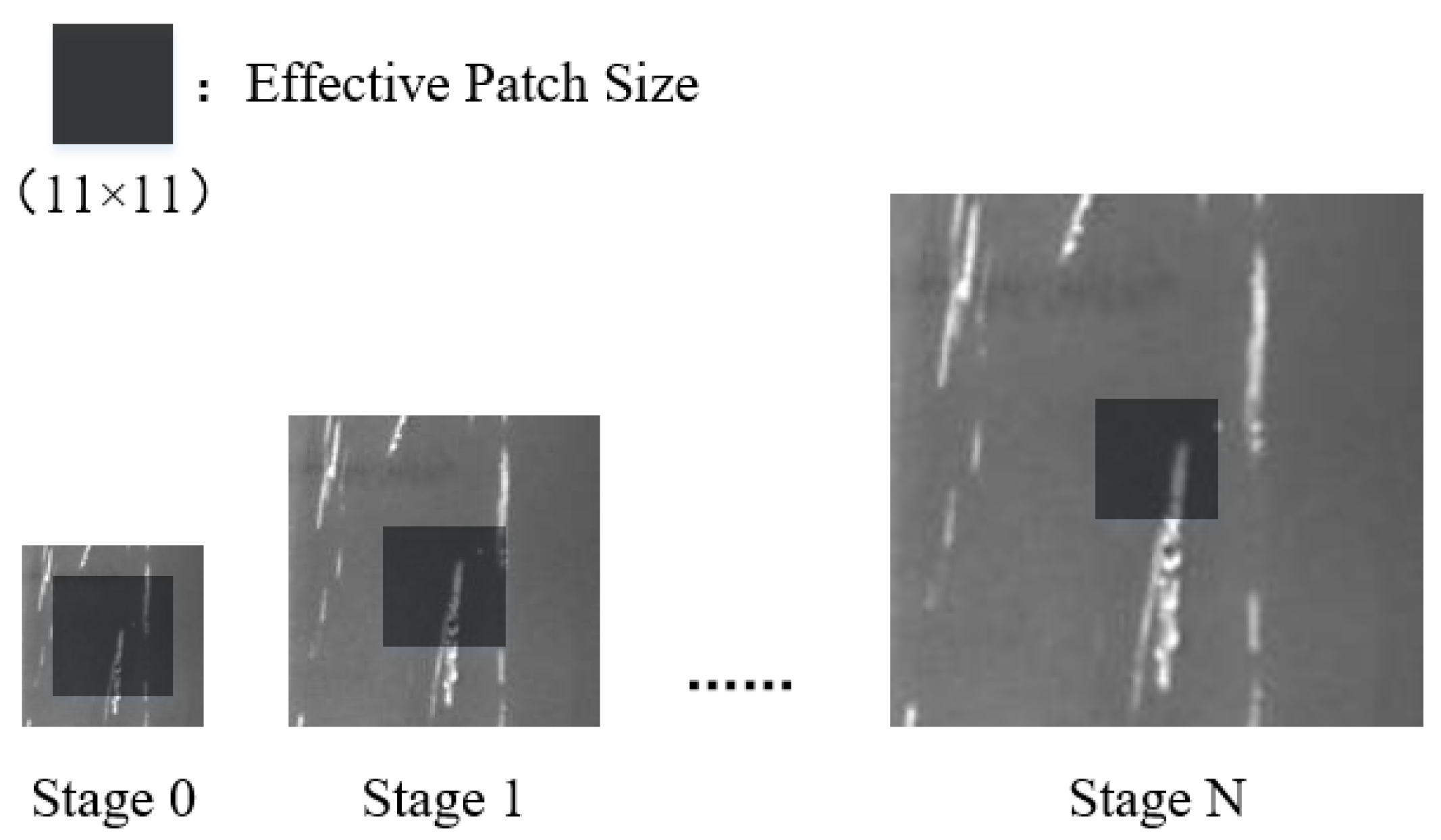
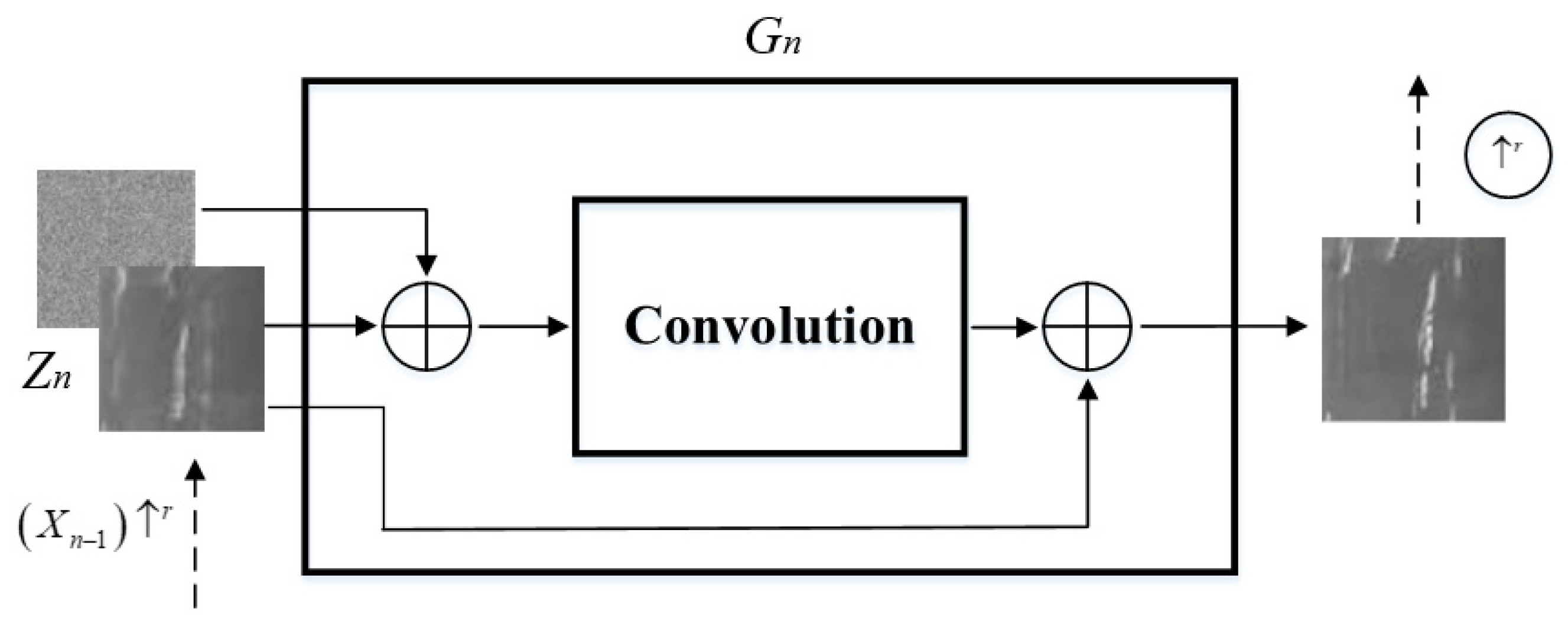
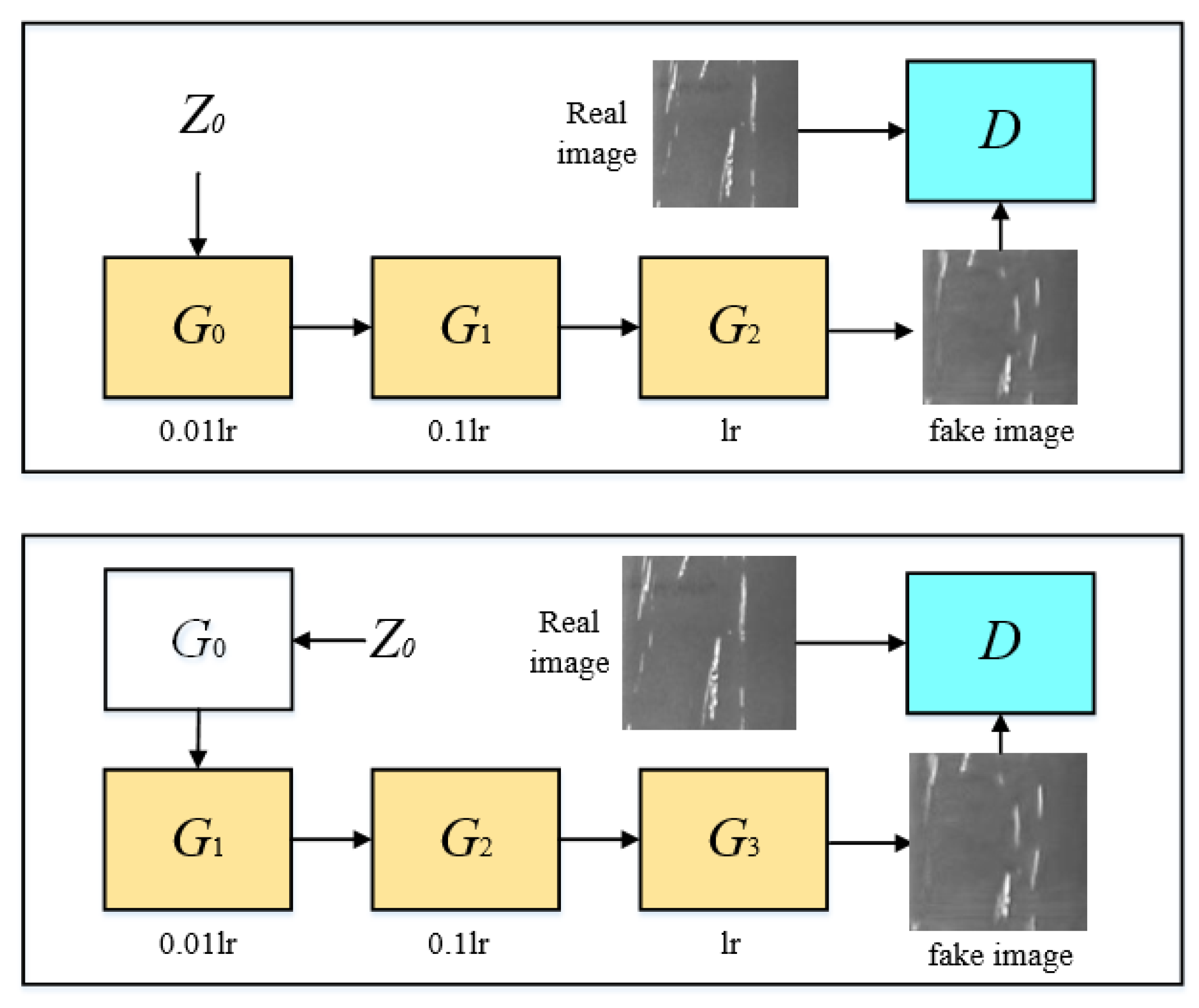

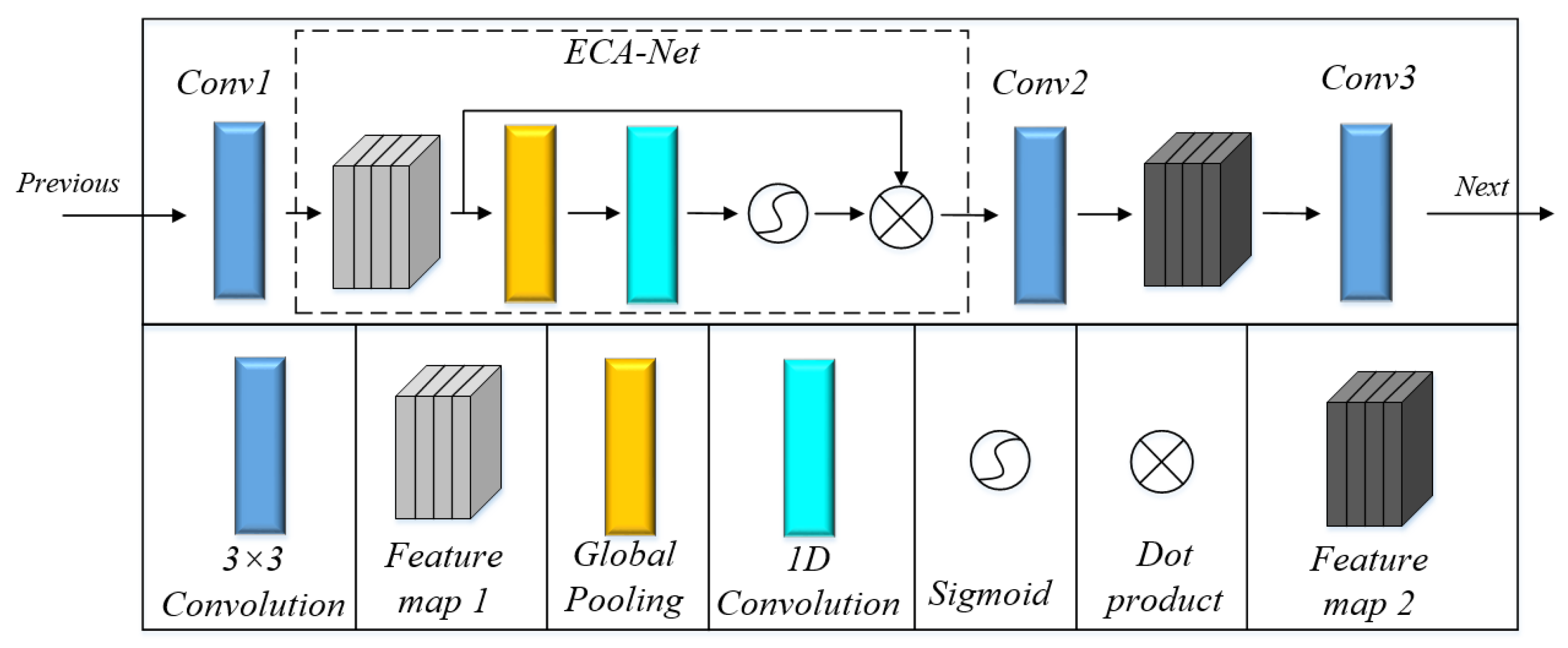
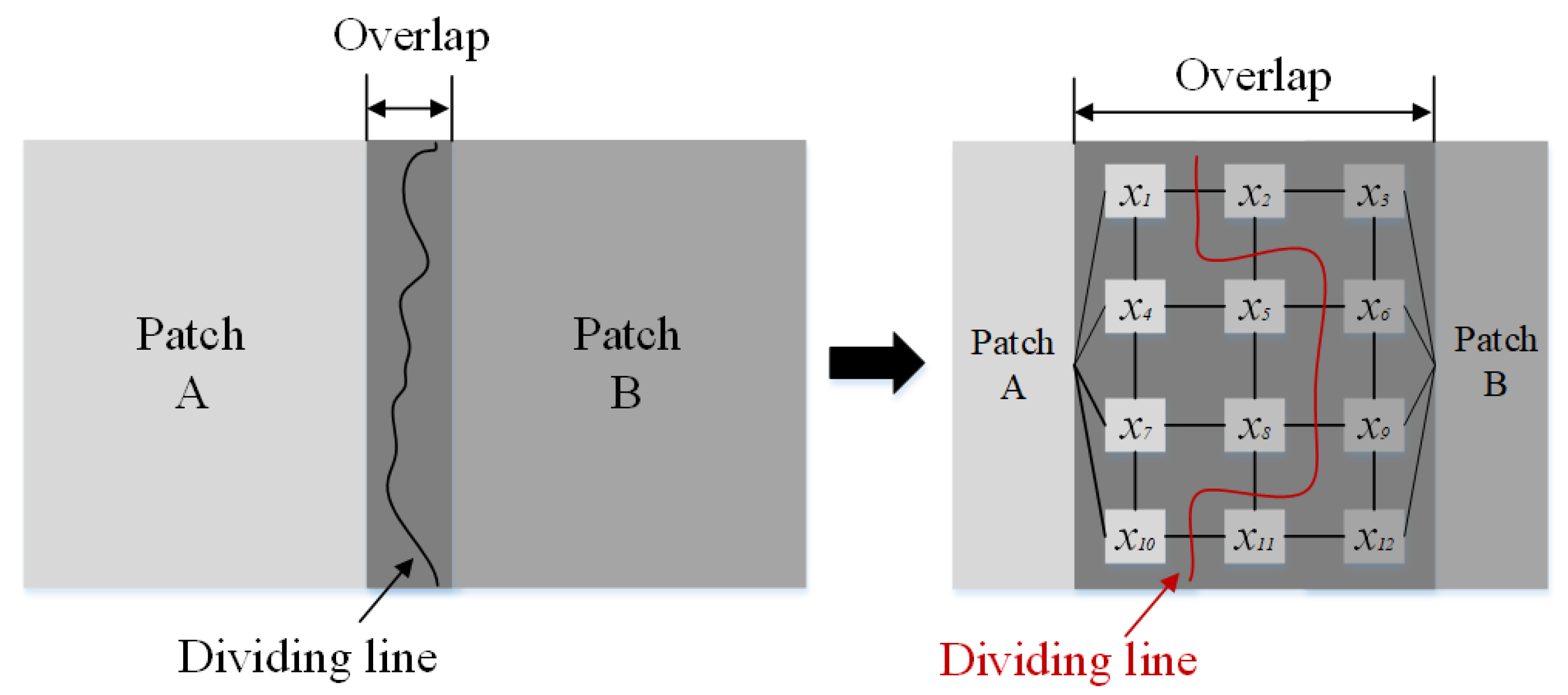

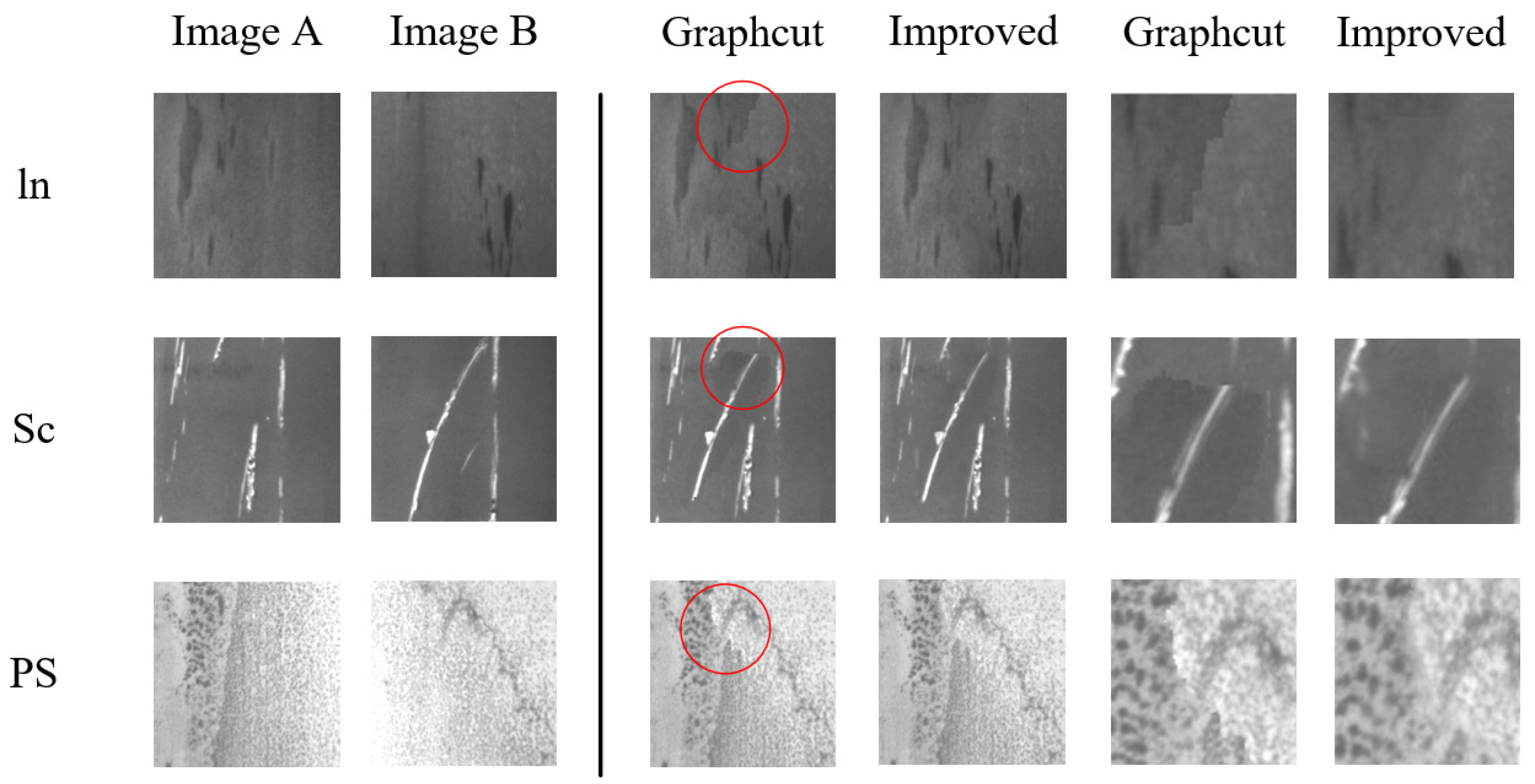
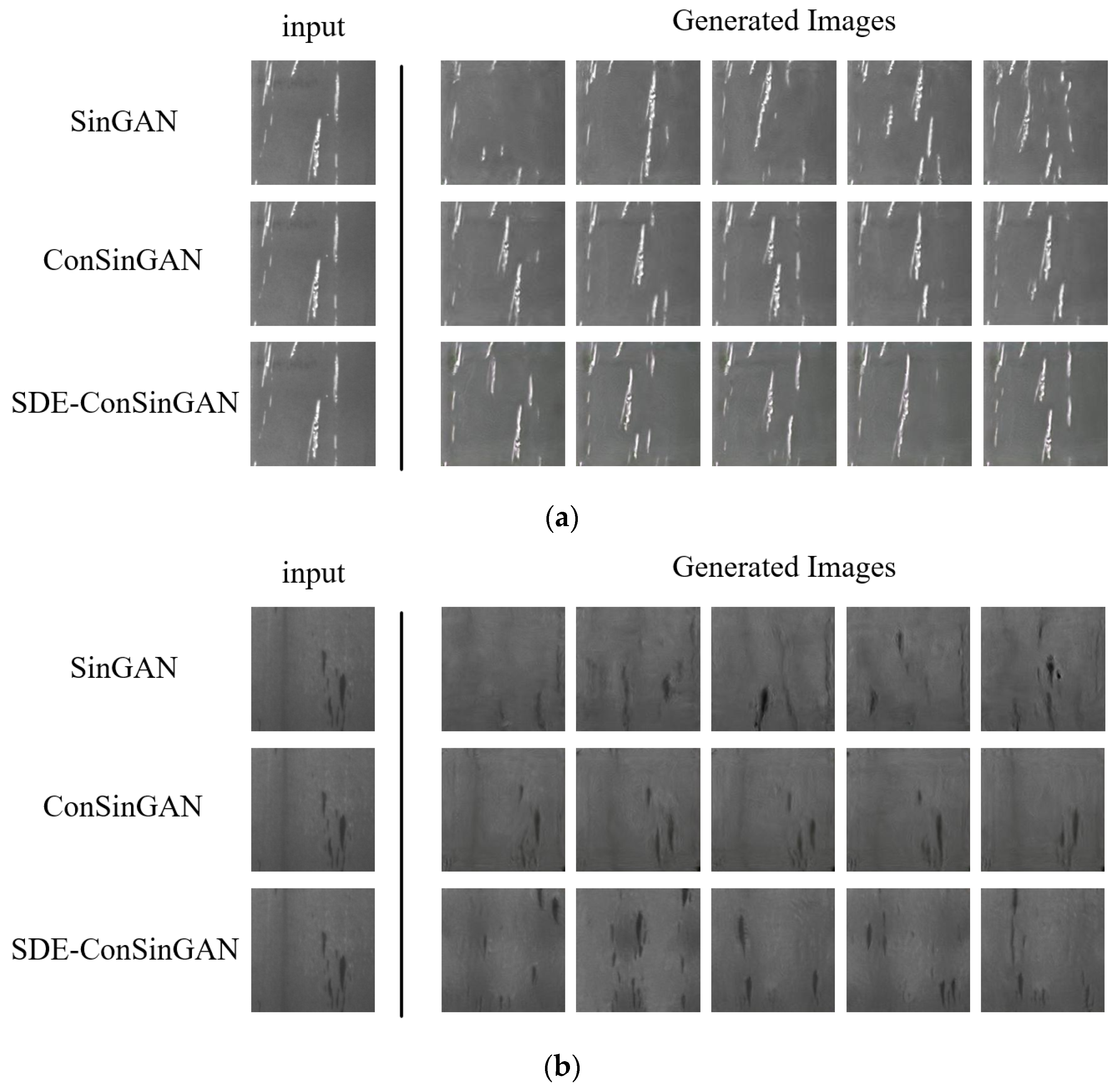

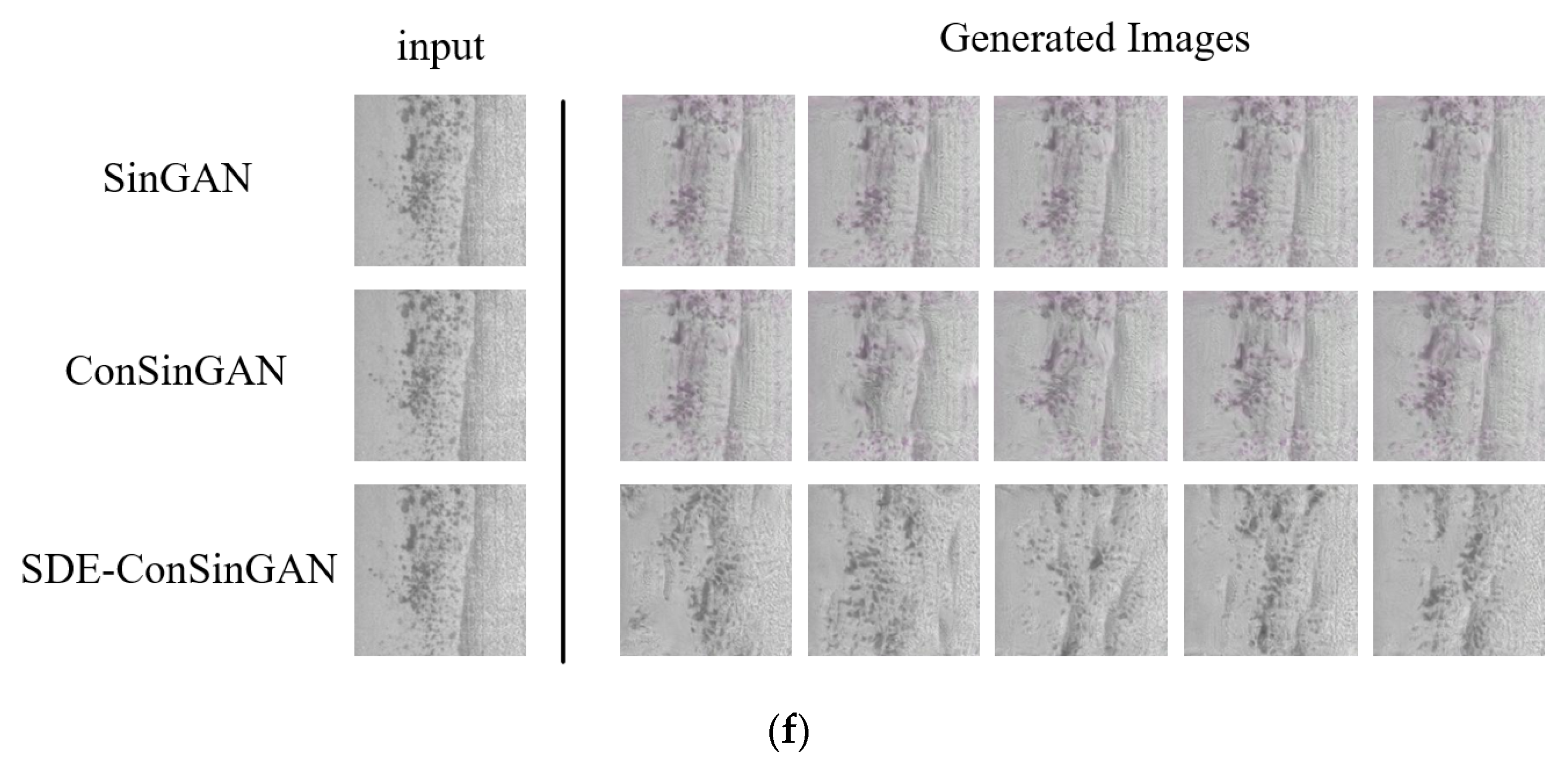
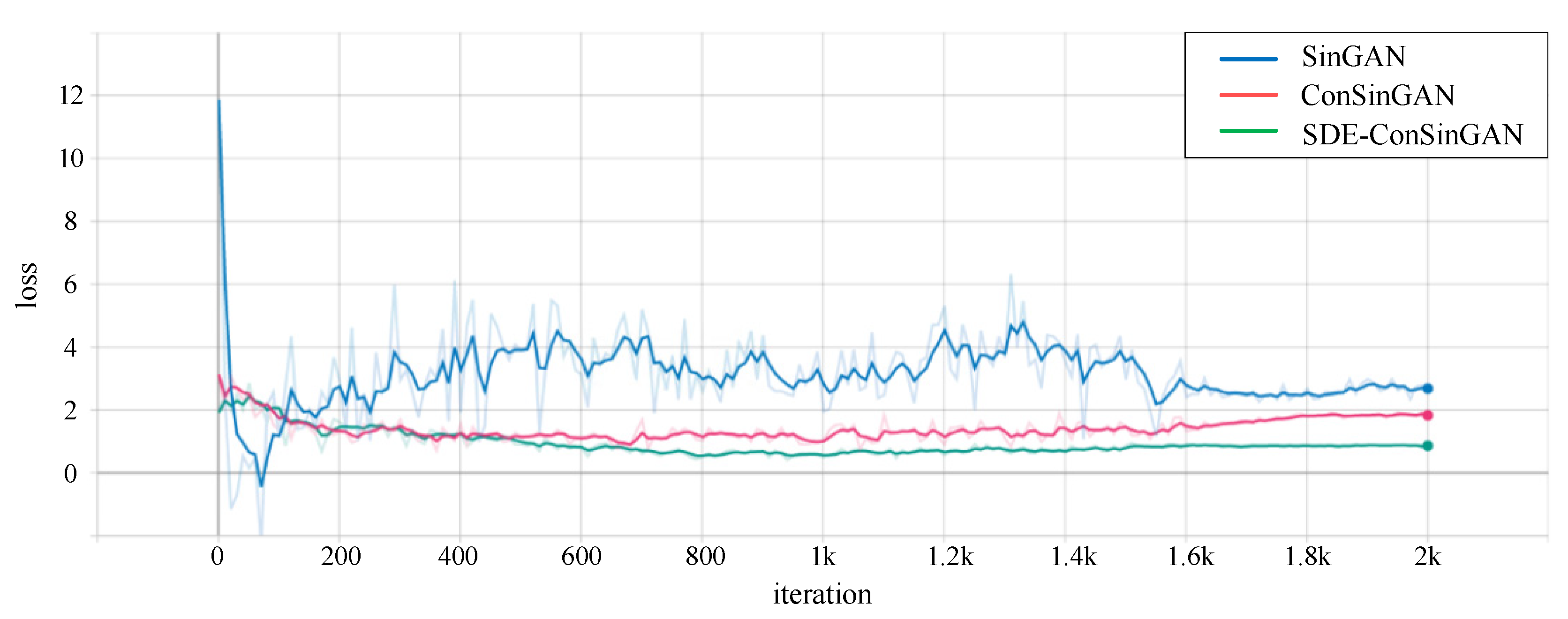

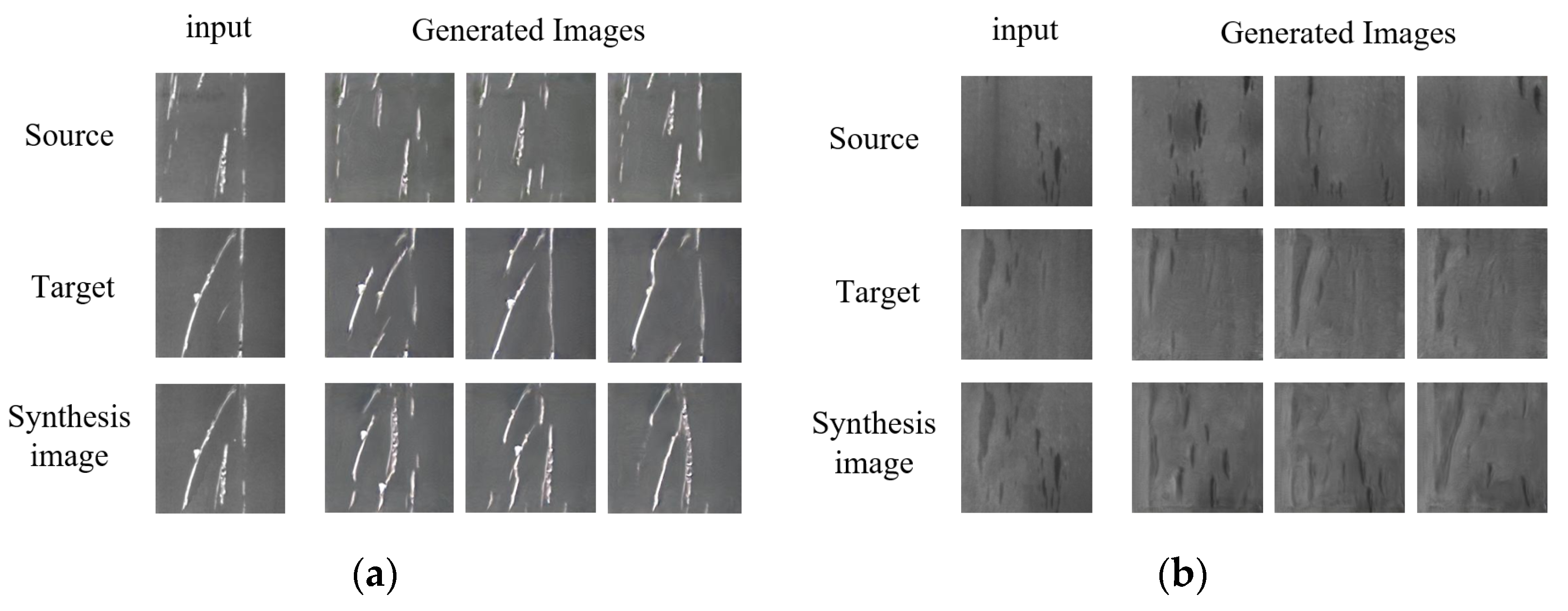


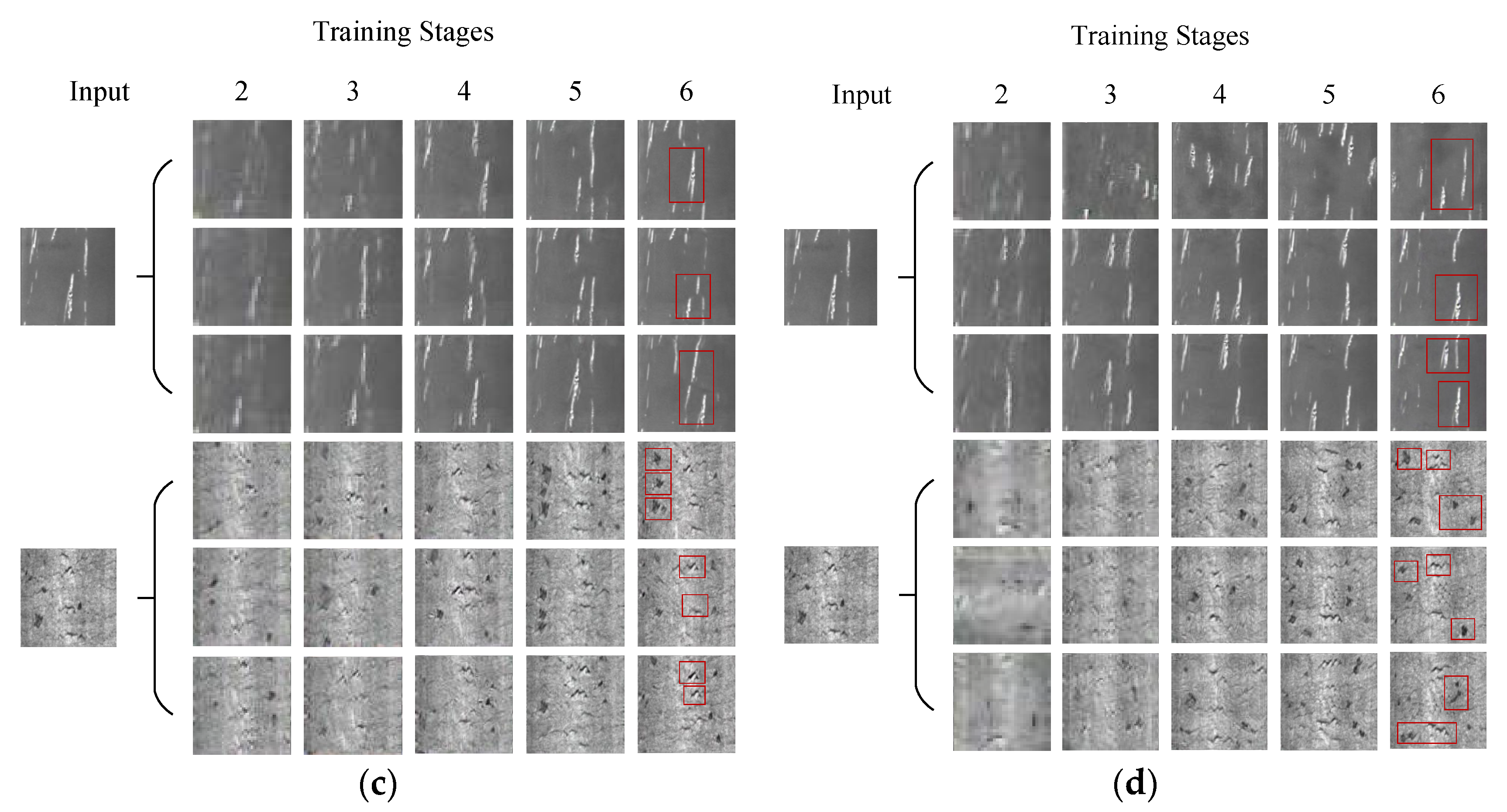

| Stage | 1 | 2 | 3 | 4 | 5 | 6 | |
|---|---|---|---|---|---|---|---|
| Model | |||||||
| ConSinGAN | 42 × 42 | 50 × 50 | 62 × 62 | 85 × 85 | 146 × 146 | 200 × 200 | |
| SDE-ConSinGAN | 55 × 55 | 89 × 89 | 124 × 124 | 151 × 151 | 170 × 170 | 200 × 200 | |
| Defect Type | Cr | In | Pa | PS | RS | Sc | |
|---|---|---|---|---|---|---|---|
| Model | |||||||
| SinGAN | 0.835 | 0.744 | 0.718 | 0.812 | 0.857 | 0.692 | |
| ConSinGAN | 0.880 | 0.790 | 0.691 | 0.803 | 0.803 | 0.613 | |
| SDE-ConSinGAN | 0.713 | 0.623 | 0.618 | 0.648 | 0.726 | 0.544 | |
| SDE-ConSinGAN + Graphcut (ours) | 0.654 | 0.559 | 0.576 | 0.607 | 0.684 | 0.521 | |
| Defect Type | Cr | In | Pa | PS | RS | Sc | |
|---|---|---|---|---|---|---|---|
| Model | |||||||
| SinGAN | 0.153 | 0.142 | 0.144 | 0.167 | 0.164 | 0.137 | |
| ConSinGAN | 0.126 | 0.115 | 0.135 | 0.162 | 0.166 | 0.128 | |
| SDE-ConSinGAN | 0.0981 | 0.0843 | 0.1013 | 0.1276 | 1.0025 | 0.1069 | |
| SDE-ConSinGAN + Graphcut (ours) | 0.0844 | 0.0732 | 0.0947 | 0.0992 | 0.0816 | 0.0850 | |
| Model | Training Stages | Epoch (Total) | Training Time (min) |
|---|---|---|---|
| SinGAN | 6 | 12,000 | 137.469 |
| ConSinGAN | 6 | 12,000 | 33.518 |
| SDE-ConSinGAN | 6 | 10,829 | 27.445 |
| SDE-ConSinGAN + Graphcut (ours) | 6 | 10,829 | 26.876 |
| Model | SSIM (Sc) | SSIM (Cr) | SIFID (Sc) | SIFID (Cr) |
|---|---|---|---|---|
| ConSinGAN | 0.611 | 0.880 | 0.128 | 0.126 |
| +Image size adjustment | 0.583 | 0.832 | 0.117 | 0.114 |
| +Iteration times variation function | 0.585 | 0.817 | 0.114 | 0.110 |
| +ECA-Net | 0.565 | 0.744 | 0.107 | 0.113 |
| Model | Predicted Time/ms | Accuracy/% | Precision/% | Recall/% | F1 |
|---|---|---|---|---|---|
| NEU (real) | 250 | 91.56 | 91.89 | 92.03 | 91.95 |
| SinGAN | 278 | 85.16 | 86.49 | 87.05 | 86.77 |
| ConSinGAN | 291 | 88.73 | 88.51 | 88.96 | 88.73 |
| SDE-ConSinGAN | 305 | 92.87 | 93.06 | 92.67 | 92.86 |
| SDE-ConSinGAN + Graphcut (ours) | 308 | 94.67 | 94.36 | 94.24 | 94.30 |
Disclaimer/Publisher’s Note: The statements, opinions and data contained in all publications are solely those of the individual author(s) and contributor(s) and not of MDPI and/or the editor(s). MDPI and/or the editor(s) disclaim responsibility for any injury to people or property resulting from any ideas, methods, instructions or products referred to in the content. |
© 2023 by the authors. Licensee MDPI, Basel, Switzerland. This article is an open access article distributed under the terms and conditions of the Creative Commons Attribution (CC BY) license (https://creativecommons.org/licenses/by/4.0/).
Share and Cite
Yi, C.; Chen, Q.; Xu, B.; Huang, T. Steel Strip Defect Sample Generation Method Based on Fusible Feature GAN Model under Few Samples. Sensors 2023, 23, 3216. https://doi.org/10.3390/s23063216
Yi C, Chen Q, Xu B, Huang T. Steel Strip Defect Sample Generation Method Based on Fusible Feature GAN Model under Few Samples. Sensors. 2023; 23(6):3216. https://doi.org/10.3390/s23063216
Chicago/Turabian StyleYi, Cancan, Qirui Chen, Biao Xu, and Tao Huang. 2023. "Steel Strip Defect Sample Generation Method Based on Fusible Feature GAN Model under Few Samples" Sensors 23, no. 6: 3216. https://doi.org/10.3390/s23063216
APA StyleYi, C., Chen, Q., Xu, B., & Huang, T. (2023). Steel Strip Defect Sample Generation Method Based on Fusible Feature GAN Model under Few Samples. Sensors, 23(6), 3216. https://doi.org/10.3390/s23063216






